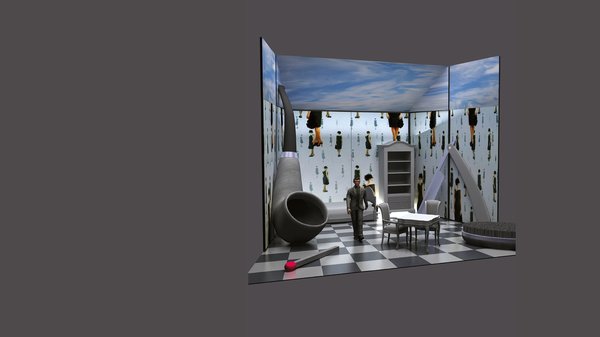
Don Pasquale
Details
In Brief
One of the best known farces in opera literature, Don Pasquale puts even the funniest films to shame with its situational comedy, colourful characters and sparkling humour. Its music is particular virtuosic: the famous duet between Doctor Malatesta and Don Pasquale makes for a perennial gala-night favourite. At the same time, delving a bit deeper into the story reveals that it is really about timeless human problems and desires, disappointments and disillusionments: an elderly gent longing for a mate, lovers yearning for a decent life, mistrustful kinsfolk, a money-hungry friend.
Csaba Káel's direction emphasises the eternal validity of the themes, showing the spectacular dramatic content at the heart of the situations, the fear of loneliness, the many faces of love, the tragedy which came within a hair's breadth of a happy ending. With nuanced devices of stylization, the production focuses on the timeless tale and its eternal relevance.
Parental guidance
Events
Premiere: Jan. 9, 2016
Synopsis
Act I
Despite his advanced age, Don Pasquale is planning to get married. The marriage he's planing, however, is not motivated by love, but by meanness and the desire to take revenge against his nephew, Ernesto, who, currently the sole heir to his legacy, has also stubbornly resisted Don Pasquale's foolish demand that he marry the rich woman his uncle has picked out for him. This is because Ernesto is in love with the young and beautiful, albeit poor, widow Norina. Don Pasquale has had enough of the lad's disobedience and therefore decides to deprive him of his inheritance. And to get back at his nephew even better, he's also going to get married himself, since this will mean that Ernesto won't be able to ask for Norina's hand at all, since he won't have a penny to offer her.
Doctor Malatesta pretends to support Don Pasquale's ridiculous plan to get married, but in reality intending to teach the old man a lesson, he hatches a scheme.
Malatesta arrives at Don Pasquale's house with the joyful news that he has found an angel from heaven to be the don's bride, and she is none other than his own sister. Malatesta's description of the girl make her out to be so lovely, gentle and submissive that Don Pasquale falls in love with her at once, without ever having seen her. When Ernesto finds out that his friend Malatesta is assisting Don Pasquale, and is even going so far as to offer up his own younger sister to be his wife, he feels horribly betrayed. After writing a farewell letter to Norina, he prepares to leave the city.Since Don Pasquale has never seen Norina, Malatesta's plan is for her to play the part of his sister, Sofronia. Norina happily agrees to take part in the game, if it will help her become united with Ernesto.
Act II
Norina appearing before Don Pasquale is a modest girl from the countryside,who is mortified with embarrassment just to be in the presence of a man. Greatly smitten, the don signs over half of his fortune and full control of his estate to Sofronia in the marriage contract. Meanwhile, the unsuspecting Ernesto arrives, but before he can ruin the deception, Malatesta lets him in on the ruse. Now enjoying the power conferred on her, fake wife Norina turns Don Pasquale's life into infernal chaos.
Act III
Spending money left and right, Norina constantly humiliates the master of the house, even going so far as to slap the don, who is gradually becoming a shadow of his former self. When Don Pasquale finds a love letter addressed to Sofronia, it's the final straw. He regrets getting married and not allowing Ernesto to marry Norina. Malatesta comes up with some new trickery: he suggests that the don can free himself from his hellish marriage if he allows Ernesto and Norino to marry, since if another woman arrives in the household, Sofronia will surely withdraw. The uncle happily allows his nephew to tie the knot, even offering money for a dowry, if only he can be rid of his impossible wife. At this point, the schemers reveal the subterfuge. Don Pasquale forgives everyone: admitting his foolishness, he gives his blessing to the loving couple.
Media
Reviews
"It is a staging by Káel where the images and paintings that appear also have the role of analyzing and interpreting the story, and become coherent parts of the director's vision. Because there is one. Thanks to the singers, among the twentieth-century paintings chosen as the background and set elements, the scenes unfolded magnificently, with different feelings and emotions alternating."
László Kolozsi, Színház.net
Opera guide
Introduction
Don Pasquale is a masterpiece flowing with unbroken momentum, a genuine opera buffa in which a wide range of emotions and moods unfold with almost cinematic speed, even within a single scene. The opera contains at least eight to ten popular numbers: among them, Ernesto’s serenade (“Com’è gentil”) and the patter duet between Don Pasquale and Malatesta (“Cheti, cheti immantinente”) appear to be the most enduring. There is no need to prove the timelessness of Donizetti’s two comic operas (L’elisir d’amore and Don Pasquale). Their evident freshness and variability (essentially lacking any fixed historical context, instead functioning as timeless emotional topographies) predestine them for longevity. Moreover, it may not be an exaggeration to say that in these works, Donizetti operates a form of modern theatre, especially when compared to his weightier operas aimed at tragic grandeur, some of which today seem more like musical historical wax museums than the kind of direct handling of subject matter we experience here.
Zoltán Csehy
The director’s concept
Donizetti’s characters are, in fact, about us, we can identify with each of them. As we grow older, we increasingly recognize the familiar situations and emotions that Don Pasquale himself experiences. This is not the archetype of Molière’s miser, but rather that of an eccentric bachelor. Another truly endearing aspect of the work is the relationship between the servants and the upper class: they hold a distorted mirror up to their masters. As viewers, we find ourselves reflected in this mirror, and suddenly we realize that we are looking at ourselves. The opera presents a talented, practical, clever, and courageous woman who is able to exploit her abilities, her troubles, and her femininity in various ways, she fights back against Don Pasquale with her own tools. When the chorus eventually presents the bill to the master, we are thoroughly entertained, because we see how successful Norina’s scheming has been: she struck Don Pasquale at his most vulnerable point, but without aiming to mortally wound him. This opera is so lovable precisely because it achieves the fulfilment of a common human wish – the triumph of love – not through silly banality, but through brilliant comedic twists.
Another of Donizetti’s timeless merits is his superb characterization. He gives sharply precise depictions of his characters and beautifully brings out their conflicts. It is this constellation of elements that makes Don Pasquale a masterpiece. The romantic tenor hero is always a bit of a problem in operas. What is there to like about them, especially when the baritone is often so much more interesting? Ernesto is full of self-pity. While Norina immediately starts plotting a solution, her lover wants to flee to the countryside to wallow in his misery. What’s also wonderful about this work is its perfect realism. Despite our initial aversion, we come to like Don Pasquale due to his genuine despair and his slowly emerging self-irony. Donizetti is a genius because he constructs an antagonist in such a masterful way that we grow fond of him along the way. We come to see that he, too, has deep feelings, and we end up pitying him. After all, it’s always easier to identify with someone who is suffering. The sharp division between male and female worlds here points not to the opposition of man and woman, but rather to the conflict between our imagination and reality. The lonely Don Pasquale conjures a woman in his imagination, building his perceived reality from his desires. Then life arrives, in the form of Norina. If this opera were staged in a contemporary setting, Don Pasquale would be searching for someone on a dating website, only to have a real woman suddenly walk into his life. It’s as if the work is reminding us: “Ladies and gentlemen! Don’t be afraid, life is far more interesting and colourful than virtual reality!”
Csaba Káel
The set designer’s concept
The stage space is a perspectival chessboard on which a complex game unfolds. It symbolically contains a male and a female space, evoking the visual worlds of René Magritte and Salvador Dalí. Don Pasquale’s objects appear on stage in exaggeratedly large proportions. This is the world of a bachelor, where there is no longer room for a woman, yet as a sign of his fantasy and desire, women are painted on the walls. What captivated us was the absurdity and surrealism of this magnified world. The aging bachelor, Don Pasquale, does not want to leave his wealth to his nephew; instead, he wants to live a little himself. He marries Norina, who immediately reveals her true nature after the wedding, she starts spending money wildly, in an effort to drive Don Pasquale out of the marriage. And yet, everyone could be happy that the aging uncle has finally found joy. A key challenge was how to bring eroticism into the production without it becoming excessive or vulgar. Norina’s dress is voluptuous, the sofa is shaped like a bosom, and the lampshade is an actual skirt. Norina is an irresistibly frivolous lady who instantly fills the bachelor’s life. As a designer, the question is always how to express all this in visual terms. During the rehearsal process, we found a true common language with the director, the costume designer, and the stage manager. When costume and set exist in symbiosis, that is, for me, the result of the best kind of creative work. The costume becomes somewhat part of the set, and the set in turn becomes part of the dramaturgy. This is my ideal of theatre.
Éva Szendrényi
